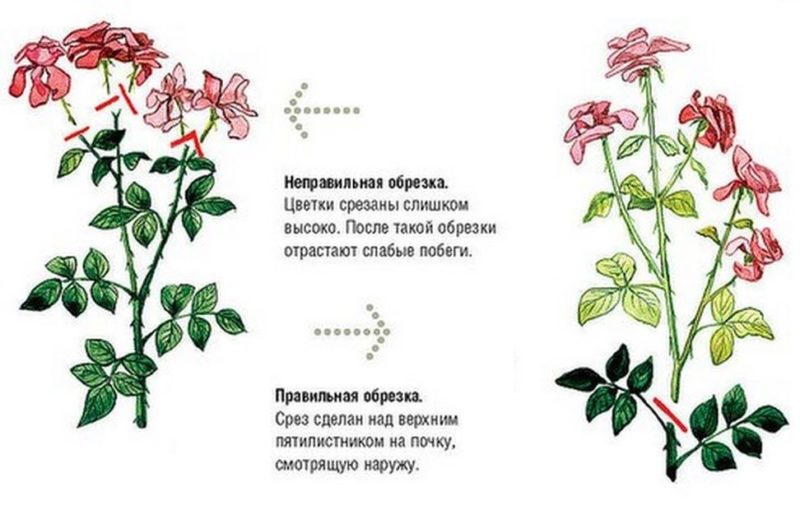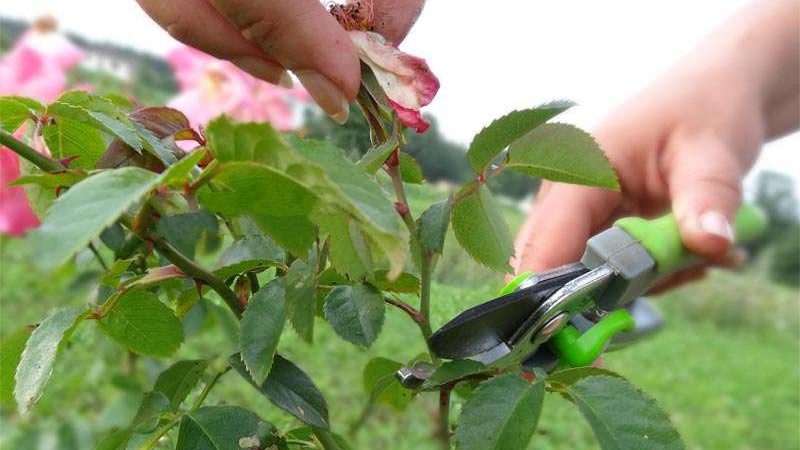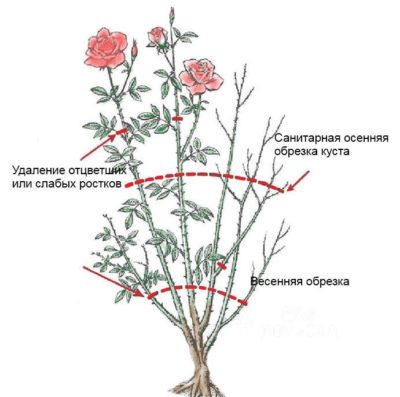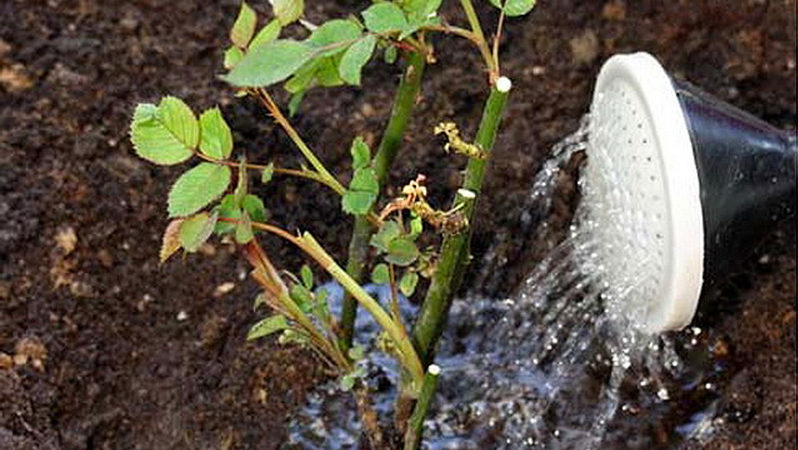Instructions for beginner growers: how to prune roses after flowering in summer so that they bloom again
Roses are able to delight flower growers with the second and third wave of flowering. To stimulate re-bud formation, it is recommended to prune wilted flowers from June to August, depending on the growing region. The purpose of the procedure is to eliminate the flabby buds that draw energy from the plant. We will tell you how to prune roses after flowering in the summer so that they bloom again, and how to properly care for the rose garden after the procedure.
The content of the article
Why prune roses after flowering
Garden rose care does not end after the first profuse flowering. Pruning wilted flowers and long stems stimulates a second wave and the bushes re-bud towards fall.
Reference. Non-repair roses bloom only once a season, so additional pruning does not stimulate re-blooming.
Pruning methods depend on the height of the bushes, species and season of the procedure. Spring haircut is performed in order to shape the bush, remove excess stems.
Autumn pruning accelerates the growth of new stems, the root system, improves the nutrition of the bush, and prevents the spread of fungal infections. Cuttings after pruning, they are not thrown away, but used to propagate roses.
Do I need to cut faded rose buds

Summer pruning is carried out to maintain the attractiveness of the bush, extend the flowering period and increase the number of buds. The plant directs all its forces to produce new shoots with buds.
Pruning is performed until the moment when the plant begins to prepare for wintering, and the branches become woody.
When to do it
Summer pruning of garden roses is performed immediately after the first wave of flowering - in June - July. The exact lines depend on the climate in the growing region. New buds will bloom 3-4 weeks after the procedure, around late July - early August.
It is important not to miss the moment and start cutting as soon as the inflorescences begin to wither and dry out. Gardeners determine the timing independently, focusing on the characteristics of the regional climate. If the procedure is carried out in the Urals or in Siberia in mid or late August, new shoots will not have time to ripen before the cold weather and will freeze. In the regions of the middle lane, the rose has a chance to release new shoots and bloom before the cold weather begins.
In the south of the country, where summers are long and warm, roses bloom 3 times. The first pruning after flowering is performed in June, the second in July - early August. In this case, only flowers are removed, capturing no more than 3 sheets.

Lunar calendar
Many gardeners prefer to follow the phases of the moon.
Auspicious days for the lunar calendar in 2020:
- June: 1–6, 8, 12, 13, 17–19, 22, 23, 26–28, 30;
- July: 1-3, 7-18, 22-31;
- August: 1, 5-10, 12-17, 21-24, 26-31.
Auspicious days in 2021:
- June: 2, 3, 6–8, 11–13, 16, 19–25, 29, 30;
- July: 3-8, 13-17, 19-23, 27, 28, 31;
- August: 1-6, 10-15, 17-19, 23, 27-31.
How to properly prune roses after flowering
To trim the bushes, a sharply sharpened pruner is used, which is pretreated with medical alcohol, a solution of copper sulfate or potassium permanganate... Garden gloves are worn to protect hands from sharp thorns.
Before pruning, the bushes are closely examined and flowers from which petals fall off are removed.Heavy blossoming buds wither and bend to the ground. At the same time, the stems that grow in the wrong direction are removed, and the excess growth that thickens the bush.
It is correct to cut over a rosette of 5 small leaves, bearing in mind that each new shoot will grow in the direction of the leaf.
Important! When pruning a shoot, a flowering shoot does not always appear above a cuttings of 3 leaves. Often new buds form in the next season.
Another important rule for pruning roses in summer is to remove buds with a branch, taking into account the growing point. At this point, the stalk is connected to the leaf, and a new shoot with a bud appears from it. The age of the bushes is also important: the shoots of annual roses are shortened by half above the growing point. Next year, 2-3 shoots will appear from each cut branch. Two-year-old bushes are cut 2-3 eyes from the base.
On bushes over 3 years old, remove dead and weakened stems, short shoots formed after cutting in the previous season.
If a gardener has to trim an entire plantation of rose bushes, it is not at all necessary to be scrupulous about the location of the cut. In this case, it is sufficient to cut the shoot at a distance of 5–8 mm above the selected leaf, since the growth points are located nearby.
It happens that a healthy shoot has not formed a bud at the end. If you look closely, you can see that he simply does not have a growth point. The upper flower bud may die due to lack of moisture or spring frost.
Such shoots are called dormant or blind. It is important to see them on time and cut them below 1-2 true complex leaves before the first flowering in spring or summer, no later than August. Otherwise, new shoots will not have time to woody before the cold weather.
What mistakes to avoid
Novice growers mistakenly remove only the upper part of the shoot - one crown.
This gentle pruning causes lateral shoots to form from the axils of the upper leaves. They grow weak and thin, and the buds are small. As a result, the bushes look untidy, bloom poorly and unattractive.
Features of pruning spray roses
Climbing, indoor and hybrid tea roses have their own particular procedure.
Pruning roses with large buds is done a little differently: they remove the stem with the flower to a certain place. In spray and tea roses, after flowering, part of the stem is removed above the first leaf.
Climbing
Climbing roses buds are formed exclusively on last year's shoots. After flowering, old shoots are cut only if new ones have already formed on the bush.
Curly bushes form horizontally. Pruning is performed at the end of August, cutting off old lashes at a height of 30–40 cm from the base.
It is interesting:
Finding out if it is possible to replant roses in August and learn to do it correctly
Simple ways to save rose cuttings until spring and plant them correctly
Room
Indoor rose is able to bloom again with proper care.
To stimulate bud formation, shoots are cut off at the beginning of spring, then the procedure is repeated when 3 living buds remain on the branches. These roses are cut by shoots growing inside the bush and with sluggish buds.
Hybrid tea

Bushes of hybrid tea roses are cut in the shape of a ball. The buds of this variety are formed on the shoots of the current year, so after flowering, gardeners have to remove most of them.
Trimming scheme:
- 2-4 buds are left on one- and two-year-old shoots, retreating 15 cm from the ground level;
- on adult shoots 4–6 buds are left, keeping a distance of 20 cm from the soil level, and on the lateral stems - 2–4 buds.
Floribunda
The floribunda variety has several flowers on one stem.
The rules for pruning it are the same as for hybrid tea roses. However, some gardeners believe that in multi-flowered varieties (floribundas, shrubs, climbing climbers, ground cover), it is important to cut the buds above the first five-leafed leaf.Both types of pruning give excellent results.
Groundcover
Ground cover roses are sheared like climbing roses. This variety simultaneously forms many flower brushes on one shoot. New lateral flower shoots are laid very quickly after summer pruning. In such plants, only the tops with dry flowers and three upper leaves are removed.
Care after pruning
After the summer mowing, the bushes need timely watering. Installing an automatic system will be ideal and free the gardener's hands from routine work. The system is adjusted so that water flows under the bush in a metered dose, with a certain frequency.
If the rose garden does not take up much space on the site, gardeners get by with manual watering. Experienced growers recommend moistening the soil only under the bush, without affecting the leaves and buds. Water consumption for 1 bush is 5-15 liters of water.

The water is pre-heated in the sun. Watering is carried out 1-3 times a week, depending on the air temperature and the degree of water absorption in the flowerbed. If the soil is dry after a day, the frequency of moisture is increased, but they try not to overflow the bushes. The root system suffers greatly from this, rot appears on the roots.
Attention! Watering is performed in the morning or evening. In the midday heat, roses are not irrigated, since drops of moisture on the leaves lead to burns.
To maintain lush flowering, the rose garden is fed with granular fertilizers, which are scattered around the trunk circle 3-4 times a season.
For foliar top dressing use liquid fertilizers and bud formation stimulants ("Epin", "Zircon", "Bud"). Any complex mineral formulations with potassium and phosphorus (for example, potassium monophosphate) are suitable.
Infusion of chicken manure (1:15) or mullein (1:10) is applied when watering in the morning or evening. In autumn, roses are fertilized exclusively with a potassium-phosphorus mixture to stimulate the ripening of shoots before wintering.
Experienced gardening tips

Tips from experienced florists will help maintain the beauty of the rose garden, achieve the second and even third flowering per season:
- Cut the withering buds as soon as the petals begin to wither.
- Cut the flower 5–10 mm above the bud, which will later produce new buds.
- On large roses, remove the stem along with the quinfoil to encourage re-blooming.
- Cut the shoot at a 45 ° angle, as a perpendicular cut increases the risk of fungal infection due to moisture that collects in this area. Drops of moisture run off faster when tilted.
- When pruning dull buds, be careful not to pinch the peduncle. After this procedure, weakened shoots grow.
- To prevent the development of fungal infections, treat damage with PVA glue.
- Treat thick and wide cuts with garden varnish or RanNet paste.
Conclusion
Summer roses are pruned from June to August. In the south of the country, the procedure begins earlier, in colder regions - a little later. Be sure to take into account climatic conditions: if you are late with a haircut, the shoots will not have time to ripen before the first frost.
In climbing species, old lashes are removed at a height of 30–40 cm from the base. In indoor roses, shoots are cut off in early spring, then the procedure is repeated when 3 living buds remain on the branches. In hybrid tea roses, 2-4 buds are left on one- and two-year shoots, 4-6 - on adult bushes. The general rule for pruning roses is to remove buds with limp petals along with 5 leaves.
After shearing, the bushes are watered 1-3 times a week, fed with bud formation stimulants, potassium-phosphorus compounds, solutions of chicken or cow dung.